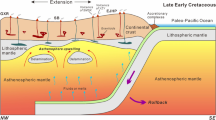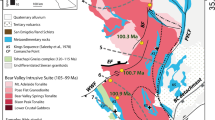Abstract
Oxygen and hydrogen isotope studies of a number of granite suites and mineral separates from the New England Batholith indicate that δO18 can be used to discriminate the major granite protoliths. The granite suites previously subdivided on the basis of mineralogical and geochemical criteria into S-type (sedimentary) and I-type (igneous) have δO18 values consistently higher in the S-type granites (10.4–12.5) than in the spatially related I-type plutons (7.7–9.9). There appears to be a systematic variation in δO18 from the most S-type to the most I-type granites, the dividing point between the two occuring at δO18 equal to 10. A group of leucocratic granites that form about half of the batholith and difficult to classify mineralogically and geochemically is found to have low δO18 values (6.4–8.1), suggesting an affinity to the most I-type granites. A single leucogranite pluton with minor muscovite has a δO18 of 9.6 which is significantly higher than other leucogranites indicating a different origin perhaps involving amphibole fractionation.
The behavior of δD in the plutonic rocks is much less systematic than δO18. Excluding samples collected adjacent to major faults, the δD values show a rough positive correlation with water content similar to, but less pronounced than, the trend previously observed in the Berridale Batholith, southeastern Australia. This relation is considered to reflect an interaction between meteoric water and the granites, the largest effect being observed in samples with the least amount of water. Of note is the generally lower δD values of the upper Paleozoic New England Batholith compared with the Silurian Berridale Batholith. This difference may be related to a near equatorial paleolatitude of 22 °S in the Silurian and near polar paleolatitudes in the late Carboniferous that have been inferred for these regions. Granite samples collected from near major faults, and one ignimbrite sample of rhyodacite composition, have very low δD values (less than −120) suggesting a much greater degree of interaction with meteoric water.
Similar content being viewed by others
References
Albuquerque, C.A.R. de: Geochemistry of biotites from granitic rocks, Northern Portugal, Geochim. Cosmochim. Acta 87, 1779–1808 (1973)
Bateman, P.C., Dodge, F.C.W.: Variations of major chemical constituents across the central Sierra Nevada Batholith. Geol. Soc. Am. 81, 409–420 (1970)
Binns, R.A.: Geological map of New England 1∶250,000-New England Tableland, southern part, with explanatory text. Univ. New England, N.S.W. 1967
Bottinga, Y., Javoy, M.: Comments on oxygen isotope geothermometry. Earth Planet. Sci. Letters 20, 250–265 (1973)
Cawthorn, R.G., Brown, P.A.: A model for the formation and crystallization of corundum-normative calc-alkaline magmas through amphibole fractionation. J. Geol. 84, 467–476 (1976)
Cawthorn, R.G., O'Hara, M.J.: Amphibole fractionation in calc-alkaline magma genesis. Am. J. Sci. 276, 309–329 (1976)
Chappell, B.W., White, A.J.R.: Two contrasting granite types. Pacific Geology 8, 173–174 (1974)
Clayton, R.N., Muffler, L.J.P., White, D.E.: Oxygen isotope study of calcite and silicates of the River Ranch No. 1 Well, Salton Sea Geothermal Field, California: Am. J. Sci. 266, 968–979 (1968)
Cole, D.R., Ohmoto, H.: Effect of NaCl on the rate of oxygen isotopic exchange reactions between rocks and water. GSA Abstracts with Programs 8, 817 (1976)
Cooper, J.A., Richards, J.R., Webb, A.W.: Some potassium-argon ages in New England, New South Wales. J. Geol. Soc. Australia 10, 313–316 (1963)
Embleton, B.J.J., McElkinny, M.W., Crawford, A.R., Luck, G.R.: Paleomagnetism and the tectonic evolution of the Tasman Orogenic Zone. J. Geol. Soc. Australia 21, 187–194 (1974)
Embleton, C.: The paleolatitude of Australia through Phanerozoic time. J. Geol. Soc. Australia 19, 475–482 (1973)
Evernden, J.F., Richards, J.R.: Potassium-argon ages in Eastern Australia. J. Geol. Soc. Australia 9, 1–30 (1962)
Flood, R.H., Shaw, S.E.: A cordierite-bearing granite suite from the New England Batholith, N.S.W., Australia. Contrib. Mineral. Petrol. 52, 157–164 (1975)
Flood, R.H., Shaw, S.E.: Two S-type granite suites with low initial 87Sr/86Sr ratios from the New England Batholith, Australia. Contrib. Mineral. Petrol, in press (1977a)
Flood, R.H., Shaw, S.E.: Evidence for crystal settling in a tilted granodiorite pluton from the New England Batholith, Australia. Contrib. Mineral. Petrol., in press (1977b)
Flood, R.H., Vernon, R.H., Shaw, S.E., Chappell, B.W.: Origin of pyroxene-plagioclase aggregates in a rhyodacite. Contrib. Mineral Petrol. (in press)
Garlick, G.D., Epstein, S.: Oxygen isotope ratios in coexisting minerals of regionally metamorphosed rocks. Geochim. Cosmochim. Acta 31, 11–214 (1967)
Gastil, R.G., Krummenacher, D., Doupont, J., Bushee, J.: The batholith belt of Southern California and Western Mexico. Pacific Geology 8, 73–78 (1974)
Helz, R.T.: Phase relations of basalts in melting ranges at PH2O = 5 kb. Part II. Melt compositions. J. Petrol. 17, 139–193 (1976)
Honma, H., Sakai, H.: Oxygen isotope study of metamorphic and granitic rocks of the Xanai District in the Ryoke belt, Japan. Contrib. Mineral. Petrol. 52, 107–120 (1976)
Kuroda, Y., Suzuoki, T., Matsuo, S., Kanisawa, S.: D/H Fractionation of coexisting biotite and hornblende in some granitic rocks masses. J. Japan Assoc. Min. Pet. Econ. Geol. 69, 95–102 (1974)
Kuroda, Y., Suzuoki, T., Matsuo, S., Kanisawa, S.: D/H fractionation of coexisting biotite and hornblende in some granitic rock masses — a supplement. J. Japan. Assoc. Min. Petr. Econ. Geol. 70, 352–362 (1975)
Magaritz, M., Taylor, H.P., Jr.: Isotopic evidence for meteoric-hydrothermal alteration of plutonic igneous rocks in the Yakutat Bay and Skagway areas, Alaska. Earth Planet. Sci. Let. 30, 179–190 (1976)
Nockolds, S.R.: The relationship between chemical composition and paragenesis in the biotite micas of igneous rocks. Am. J. Sci. 845, 401–420 (1947)
O'Neil, J.R., Chappell, B.W.: Oxygen and hydrogen isotope relations in the Berridale Batholith, Southeastern Australia. J. Geol. Soc. London, in press (1977)
O'Neil, J.R., Taylor, H.P., Jr.: The oxygen isotope and cation exchange chemistry of feldspars. Am. Mineralogist 52, 1414–1437 (1967)
Pitcher, W.S.: The Mesozoic and Cenozoic batholiths of Peru. Pacific Geology 8, 51–62 (1974)
Pogson, D.J., Hitchins, B.L.: New England 1∶500,000 Geological Sheet. Sydney, Geol. Surv. N.S.W. 1973
Reed, B.L., Lanphere, M.A.: Chemical variations across the Alaska-Aleutian Range Batholith. J. Res. U.S. Geol. Survey 2, 343–352 (1974)
Savin, S.M., Epstein, S.: The oxygen and hydrogen isotope geochemistry of ocean sediments and shales. Geochim. Cosmochim. Acta 34, 43–63 (1970)
Shieh, Y.N., Schwarcz, H.P.: Oxygen isotope studies of granite and migmatite, Grenville province of Ontario, Canada. Geochim. Cosmochim. Acta 38, 21–45 (1974)
Shieh, Y.N., Taylor, H.P., Jr.: Oxygen and hydrogen isotope studies of contact metamorphism in the Santa Rosa Range, Nevada and other areas. Contrib. Mineral. Petrol. 20, 306–356 (1969)
Suzuoki, T., Epstein, S.: Hydrogen isotope fractionation between OH-bearing minerals and water. Geochim. Cosmochim. Acta 40, 1224–1240 (1976)
Taylor, H.P., Jr., Epstein, S.: Relationship between O18/O16 ratios in coexisting minerals of igneous and metamorphic rocks. Geol. Soc. Am. Bull. 73, 461–480 (1962)
Taylor, H.P., Jr., Turi, B.: High-O18 igneous rocks from the Tuscan Magmatic Province, Italy. Contrib. Mineral. Petrol. 55, 33–54 (1976)
Tuttle, O.F., Bowen, N.N.L.: Origin of granite in the light of experimental studies in the system NaAlSi3O8-KAlSi3O8-SiO2-H2O. Geol. Soc. Am. Mem. 74 (1958)
Wilkinson, J.F.G.: The New England Batholith. In: Geology of New South Wales (G.H. Packham, ed.). J. Geol. Soc. Australia 16, 271–278 (1969)
Wilkinson, J.F.G., Vernon, R.H., Shaw, S.E.: The petrology of an adamellite porphyrite from the New England Batholith (New South Wales). J. Petrol. 5, 461–488 (1964)
Author information
Authors and Affiliations
Rights and permissions
About this article
Cite this article
O'Neil, J.R., Shaw, S.E. & Flood, R.H. Oxygen and hydrogen isotope compositions as indicators of granite genesis in the New England Batholith, Australia. Contr. Mineral. and Petrol. 62, 313–328 (1977). https://doi.org/10.1007/BF00371018
Received:
Accepted:
Issue Date:
DOI: https://doi.org/10.1007/BF00371018




